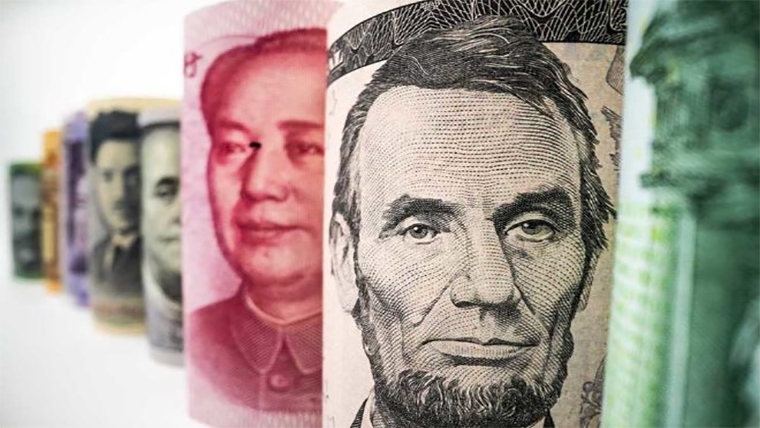
By Stuart Talman, XE currency strategist

A predictably quiet start to the week has kept price action in tight ranges. Of note, US bond yields extend higher for the third consecutive trading day, ensuring the US dollar remains bid.
Starting the week near 62 US cents, the New Zealand dollar has shed around a third-of-a-percent through Monday, ranging between 0.6160 and 0.6210. Following Friday’s swift rejection of 63 US cents, a second day of losses forces the Kiwi into the lower half of a 0.6100 – 0.6300 range that has captured much of the past two months price action.
From late March onwards, the Kiwi found support on multiple occasions around 0.6180, a level that now looks to be caving as US bond yields continue to rebound from their March lows amidst US banking turmoil.
With the near crisis in the rear-view, focus has shifted back to the Fed. Market pricing has firmed in favour of another 25bps hike over the past fortnight, 30-day Fed funds futures now assigning over an 80% probability of the target rate being lifted to 5.00%-5.25%.
The dollar’s slide has been halted.
Should the Kiwi break below a critical 0.6140/80 support zone the neutral bias that has evolved from mid-February shifts to negative, likely leading to a re-test of the year-to-date low at 0.6084.
We’d need to see a run of upside beats for US macroeconomic data and a stronger than expected 1Q earnings season (commenced on FRI.) to shift the bond market’s outlook for 2H rate cuts. Stripping out the ~50bps of easing currently priced in would facilitate the next leg-up for bond yields and a sustained run higher for the dollar.
Dollar weakness has been a popular call of late, the dollar bears believing the Fed has done enough to rein in inflation and cool the economy. Some believe the Fed has over-tightened, evidenced (in their opinion) by March’s SVB and Signature Bank failures.
The Fed believe they have more work to do via the mix of additional hikes and holding the policy rate at its peak for an extended period. Jay Powell and his FOMC colleagues do not foresee the need to cut rates until well into 2024.
At some point the Fed’s outlook and the bond market’s outlook will converge as one is proven correct.
If the Fed is right, expect US dollar strength through the middle part of the year.
If the bond market is right, the outlook is murky.
Fed rate cuts in 2H 2023 would likely occur due to a crisis of some sorts and/or the US economy rapidly deteriorating, plunging into recession. In this scenario the dollar could attract safe haven flows, or as we witnessed over the past 6 weeks, it could weaken if financial stress is concentrated in US markets.

Shifting our focus back to the upcoming 24hours, it’s a busy docket.
Regionally RBA meeting minutes, and China activity data will be the focus.
Having paused earlier in the month, following 10 consecutive rate hikes, the RBA is expected to maintain the cash rate at 3.60%, interest rate futures assigning a ~90% probability of no-change. The minutes will be scrutinised to confirm this bias.
Following last week’s stronger-than-expected AUS jobs numbers, an upside beat for next week’s quarterly CPI may be enough for the RBA to shift back into hiking mode.
Having topped out near 0.9450 earlier in the month, NZDAUD has swiftly reversed course, a sixth day of losses forcing the pair through 0.9220.
Delivering a surprise 50bps hike two weeks back, the bar is now set significantly higher for an RBNZ hawkish surprise relative to the RBA.
A busy week for UK data delivers jobs numbers (TUES.), CPI (WED.) and retail sales (FRI.). Data flow out of the UK has been robust of late, requiring the Bank of England to further tighten, lifting the policy rate to 4.25%.
The pound has been one of the strongest performing currencies, year-to-date, outpaced only by the euro and Swiss franc amongst the G10 cohort.
From its February high north of 0.5300, NZDGBP has retreated over 6%. The past week’s price action dipped below 0.5000, logging 6-month lows.
Should this week’s UK dataflow lean soft, signalling the Bank of England may follow the RBA and Bank of Canada, being the next major central bank to enter a pause phase, expect NZDGBP to establish a base around 0.5000.
Tomorrow’s CPI number is the critical data point. If core UK inflation prints north of 10%, the BoE likely hikes at its 11 May meeting, delivering further GBP strength.
Fed officials’ speeches will be in focus in US trade given a very quiet US calendar, this week.
Can the Kiwi find a foothold, remaining above the 0.6140/80 support zone?
If support fails to hold, we’re shifting from a neutral to negative bias.
Daily exchange rates
Select chart tabs
Stuart Talman is Director of Sales at XE. You can contact him here.

We welcome your comments below. If you are not already registered, please register to comment
Remember we welcome robust, respectful and insightful debate. We don't welcome abusive or defamatory comments and will de-register those repeatedly making such comments. Our current comment policy is here.